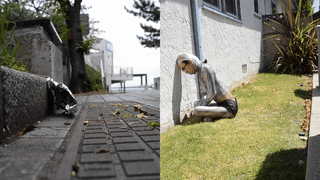First, Littered MVMNTS [https://www.instagram.com/litteredmvmnts/]: kind of an inverse portraiture of a human mimicking the motion of trash through choreographed movements. I like how the artist is using his art to bring attention to an environmental issue (and utilizing instagram/tik tok platforms to do so, e.g. he selects 15 second snippets), the choices of costume, and that–in line with his message–he picks up the trash when he’s done.

Next are these silver gelatin photographic prints of religious statues defaced by Khmer Rouge looters between 1975-1979 developed by Zhi Wei Hiu (and captured by Zhi’s uncle). Zhi developed these images, which were stored for 30-40 years in non-archival conditions (the photos themselves were taken by his uncle), resulting in signs of fungal growth on the negatives. Zhi further coats the surface of the paper with zinc oxide, an abrasive which captures the motion of a silver stylus across the paper. I thought this was an interesting example of “temporal capture” because the photographic duplicates of the real objects, left to the devices of nature and time, also capture the decay of the captured object.

In this photo Zhi is demonstrating how they want the photo to be displayed for an upcoming exhibition
Finally, Pipilotti Rist’s Open My Glade (Flatten), which shows a video projection of her seemingly pressed against a glass surface, moving side to side, on the large windows at the New Museum’s entrance. This work appeals to me as an example of portraiture because it’s kind of grotesque (and with some scale) while being in a genre and exhibition setting that usually aims for flawlessness. I also like the paradoxes in this image–how we are both given and denied a sense of corporality and how the display medium is suggested by the media (window), but is not the one that caused the effect (pressed against glass).
